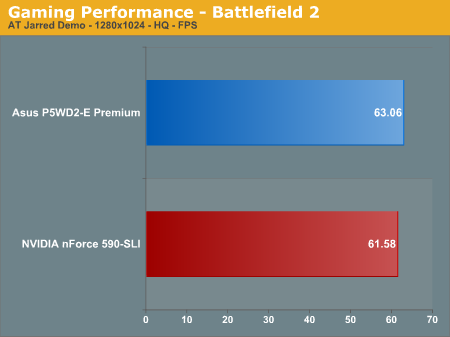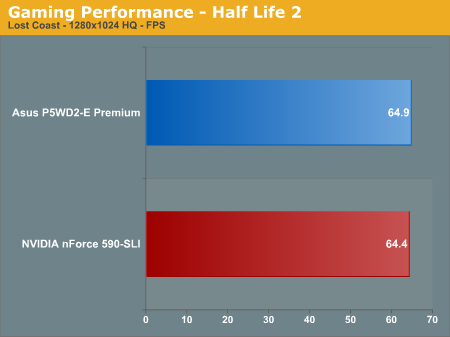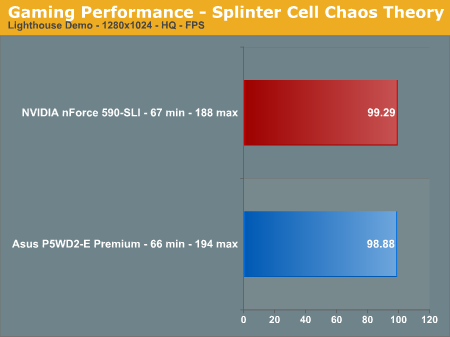nForce 590 SLI Intel Edition: NVIDIA prepares an Intel 975X Killer
by Gary Key on June 27, 2006 6:15 AM EST- Posted in
- CPUs
Gaming Performance






The overall gaming performance of both platforms with the Pentium D 805 is actually very good considering the processor speed and heavy reliance upon the video card to generate these scores. As in the synthetic tests, it is a toss up in regards to the performance results. We still believe NVIDIA can extract additional performance from their BIOS that should result in a sweep of these benchmarks provided the Intel 975X performance remains static in the Core 2 Duo friendly boards.
Final Words
Our first tests with the NVIDIA nForce 590 SLI Intel Edition reference board certainly shows promise against one of the better performing Intel 975X boards currently on the market. Based upon the progress NVIDIA has made over the past two weeks with BIOS updates and a new board revision, we are very optimistic about this chipset performing equal to or better than the Intel 975X at this time. Of course, until we are able to fully test a production ready nForce 590 SLI Intel Edition board along with the soon to be released Core 2 Duo ready 975X boards, we cannot conclude with confidence which chipset will cater to the gamer, enthusiast, or hard core overclocker. We do know that if you want to use SLI then NVIDIA is the only game in town for the Intel platform.
Our focus in the next round of testing will be on overclocking and memory performance. The current memory performance of the NVIDIA board is slightly better than our i975X test board; although without further BIOS options it is difficult to really do an apples to apples testing at the higher memory speeds. Overall, the performance of the reference board was stellar in our testing while providing very good overclocking capabilities considering the early nature of the board and BIOS. Hopefully, we will see higher FSB speeds out of this chipset compared to earlier NVIDIA offerings for the Intel market. We already know they have an extensive feature set and excellent memory performance; it is time now to see how well these new chipsets can overclock the front side bus.
We will back shortly with updated benchmarks featuring several Intel dual core processors but unfortunately we cannot provide Core 2 Duo benchmarks for a few more weeks. Until then, all we can say is get ready for a gunfight at the O.K. Corral between these two chipsets.






The overall gaming performance of both platforms with the Pentium D 805 is actually very good considering the processor speed and heavy reliance upon the video card to generate these scores. As in the synthetic tests, it is a toss up in regards to the performance results. We still believe NVIDIA can extract additional performance from their BIOS that should result in a sweep of these benchmarks provided the Intel 975X performance remains static in the Core 2 Duo friendly boards.
Final Words
Our first tests with the NVIDIA nForce 590 SLI Intel Edition reference board certainly shows promise against one of the better performing Intel 975X boards currently on the market. Based upon the progress NVIDIA has made over the past two weeks with BIOS updates and a new board revision, we are very optimistic about this chipset performing equal to or better than the Intel 975X at this time. Of course, until we are able to fully test a production ready nForce 590 SLI Intel Edition board along with the soon to be released Core 2 Duo ready 975X boards, we cannot conclude with confidence which chipset will cater to the gamer, enthusiast, or hard core overclocker. We do know that if you want to use SLI then NVIDIA is the only game in town for the Intel platform.
Our focus in the next round of testing will be on overclocking and memory performance. The current memory performance of the NVIDIA board is slightly better than our i975X test board; although without further BIOS options it is difficult to really do an apples to apples testing at the higher memory speeds. Overall, the performance of the reference board was stellar in our testing while providing very good overclocking capabilities considering the early nature of the board and BIOS. Hopefully, we will see higher FSB speeds out of this chipset compared to earlier NVIDIA offerings for the Intel market. We already know they have an extensive feature set and excellent memory performance; it is time now to see how well these new chipsets can overclock the front side bus.
We will back shortly with updated benchmarks featuring several Intel dual core processors but unfortunately we cannot provide Core 2 Duo benchmarks for a few more weeks. Until then, all we can say is get ready for a gunfight at the O.K. Corral between these two chipsets.










37 Comments
View All Comments
bespoke - Tuesday, June 27, 2006 - link
Once again, the southbridge chip and fan are right underneath the top video card clot. A large cooling solution on the video card will completely cover the sb chip - possibily preventing the video card from seating correctly and certainly not helping with airflow.Please move the SB chip or get rid of the fan! Arrrgh!
Gary Key - Wednesday, June 28, 2006 - link
Due to the required two chip solution for dual x16 GPU operation, there is not another area on the board to place the chipset and still retain the required trace layouts. Due to the heat generated by the MCP, it requires active cooling or a large passive heatsink (as MSI did on their 570 board). These issues will be solved late this year when NVIDIA goes to a single chip solution for their dual x16 boards. In the meantime, we are not happy either. ;-)
Anemone - Thursday, June 29, 2006 - link
Probably should use DDR2 800 on the Asus and 667 on the 590 as the highest supported on each and recompare. I know that feels unfair but I'm saying that from a "highest supported" basis. Enthusiasts are likely to go beyond that, but you'll be giving the full oc tests a go in the next round.Initially however think 533 on both skewed things.
Per Hansson - Tuesday, June 27, 2006 - link
"The reference board features an excellent voltage regulator power design along with Rubycon and Sanyo capacitors that yielded superb stability and overclocking results even with our early BIOS and board design."Actually those capacitors with a T vent are Panasonic FL, in the 12v input for the VRM and also for the 5v or 12v input for the memory regulators...
Still very excellent capacitors; if it only where a requirement to also use them on the revised boards by the mainboard manufacturers... Wishful thinking I guess but with continued reporting of what components are used like this by you Anandtech eventually they will listen... (I hope atleast) Again thanks and great work! Hoping you will help to ease the confusion on what chipset to go with that Conroe...
Griswold - Tuesday, June 27, 2006 - link
For some reason, pictures of the mobo wont show in Opera (v9) for me. The benchmark charts are there though. What gives? Anyone else experience this?Never had any kind of problem with Opera and AT before. :/
Per Hansson - Tuesday, June 27, 2006 - link
Works fine in Opera 9 here, I think your issue might be that your browser is not set to enable refferer logging (under advanced>network)Griswold - Tuesday, June 27, 2006 - link
That was it. Not sure why that one was off, however, it works now. Thanks a bunch!Gary Key - Tuesday, June 27, 2006 - link
I will load up Opera 9 and test it shortly.Myrandex - Tuesday, June 27, 2006 - link
That eSata port looks a lot like the ieee1394B port, any relation? I heard there was apush once for eSata to use Firewire cables, but I thought only one manufacturer was trying for that (maybe Highpoint?).eskimoe - Tuesday, June 27, 2006 - link
First off, thanks for one of the very few test on the new nforce5 intel edition!For a long time now I have built my pcs with amd cpus, next month will be the first time since the first p3s that Ill build another intel pc!
So at the moment, I am not really sure which chipset to use,
of course it seems natural to use an intel chipset for an intel cpu..
but the nforce chipsets have been very nice (at least for amd), and theres more competition than in the intel area...
The only thing that intel has and nvidia doesnt, is the intel matrix storage
(btw, a single nvidia card shouldnt have any probs running on an intel board/have disadvantages over a single ati card, should it?),
which sounds very nice in my opinion.. therefore, I'd love to see
some comparison in the RAID compartement between nforce5 and intel 975/965,
especially since I cant find any information how RAID5 performs on
nforce5 and intel chipsets.. until now, all onboard variants were
very slow/used alot of cpu (at least when writing)
So, I'd love to see some tests comparing raid0 performance/cpu utilization
between the chipsets, as well as raid5 tests...
and perhaps someone knows of some tests on matrix raid 5?
The possibility to have 3x200gb drives, using for example 500gb as raid0,
and 100gb as raid5 seems very promising, as long as the raid5 calculations
are somewhat supported by chipset hardware, not only the cpu!
Thanks alot